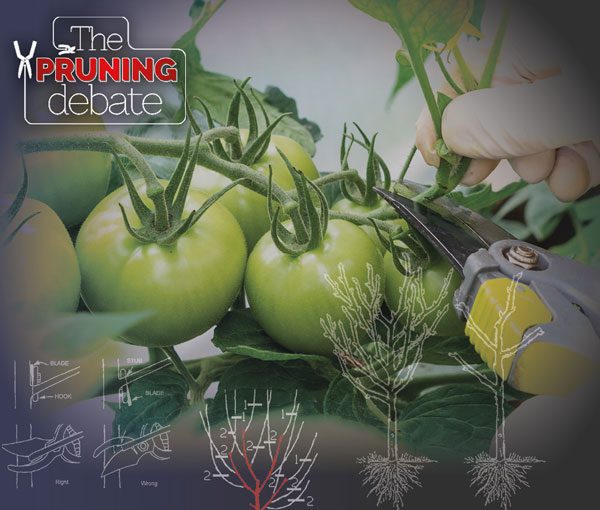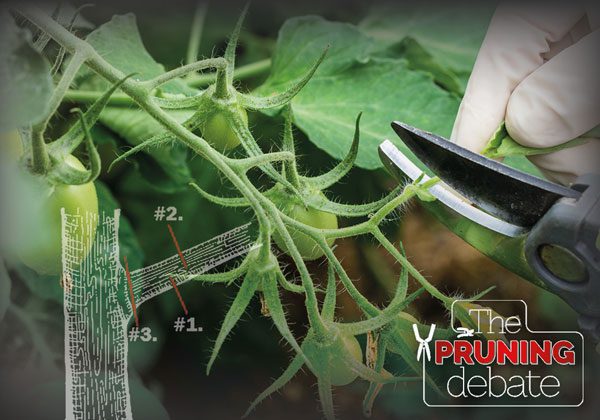As with most topics in the horticultural world, if you ask the internet or a selection of growers for advice on pruning flowering plants, you’ll get different opinions. Even plant scientists will find unexpected results in this area, although, not necessarily surprising.
What is the best way to prune for yield?
Well, in reality, there are as many answers as there are plant species. A quick online search for the species you have (provided you search for advice from a recognized horticultural institution) will tell you what time of year or phase of growth is best for pruning. So, why is there still so much debate on this issue? More interestingly, what are the basics we need to know before we start?

If you suspect that this is yet another plant-based debate where the only universally correct answer is “balance”, you are right. Like the hippies say, “in all living things, energy is shared.” Balance isn’t just important: it’s unavoidable.
Plant Feelings
Just like us, plants run on a metabolic network, and every living cell in a plant makes demands on that network for food and water that must be balanced. That process of resource attribution is called partitioning.
Have you ever heard someone talk about applying a specific treatment or product to a plant and making it do something? It can sound a bit anthropomorphic. Treat plants a certain way, and you can let them know they are going to die. In response, the plants will change their behavior. For example, If you allow lettuce to repeatedly dry and wilt before re-watering and feeding it, it will bolt or go into flower. It is inevitable, no matter how much nitrogen and veg boosting products you supply it. It “thought” it was going to die, and so it put all available resources into reproduction, or flowering and seeding.
Many scientists and science communicators (myself included on most days) don’t mind this intention-based way of talking about biology, plants, or humans. It comes naturally and is relatable. However, many flat out reject this idea. The problem is it’s not technically true in the sense that plants don’t “know” anything. They, similar to the unconscious physical processes regulating our metabolisms and keeping us alive, are complex self-righting mechanisms, where a myriad of interconnected balancing acts tend to push the overall system one way or another depending on circumstances.
Plants have experienced a wide range of situations over their evolutionary history, such as unstable weather and nutrient supply, high pathogen levels, and more. Those that have
survived, especially those adapted to non-specialist or varying conditions, have a range of different growth responses available to them.
These responses and the flexibility of the resource partitioning system that powers them is what allows us to manipulate plants in so many ways, making them grow and yield differently compared to how they perform in their natural habits.
Plant Basics
Reproducing is a non-negotiable requirement for existence, and flowering and fruiting are evolved responses to the challenges of doing so effectively over the long term. So, it’s not surprising that more energy is needed if plants are taking a shortcut to flower, devote, or partition. This is where balance and oxygen come back in.
Remember oxygen? The thing that keeps your plant’s roots from drowning and rotting? It turns out it’s not just your roots that need that sweet, sweet O2.

We already know that plants make their food through photosynthesis and give out oxygen. Water, sunlight, and air come in, oxygen and food go out. Right?
Well, sort of. Every cell needs to make energy (food), then burn it with sunlight and unicorn tears. Just like us, to break sugars down and make the molecules that power cellular mechanisms, they need oxygen in every cell. Keeping an oxygenated root zone isn’t just crucial for plant health in an abstract way. It directly fuels every cell in the organism, and if there isn’t enough, growth will be limited. So, here’s what you need to know:
● Plants partition energy resources internally between areas and different activities (roots, leaves, flowers/growing, reproducing, etc.) depending on the circumstance.
● Plants get energy from the sun through their leaves.
● They transport that energy around internally as sugars.
● All cells in plants use energy to survive and reproduce (plant growth).
These are the basics of the pruning debate. The reason there is so much confusion, differing opinions, and results, is mainly because all the factors at play are interconnected and interdependent.
Despite all this apparent complexity, the idea is very straightforward. When a plant is in flower, it allocates a higher percentage of its energy resources to flowering than it does in vegetative growth. So, if you prune or remove leaves during flowering, it is possible all of the plant’s resources will go towards flower rather than leaf replacement. However, go too far with the pruning, and the loss of leaf area will restrict the plant’s ability to make food for growth, which results in fewer flowers and fruit yields. In a nutshell, flowers can be restrained by either having too many leaves or not enough of them.
What is the solution? Balance.
One of the most current scientific studies on this subject is a Dutch paper by S Xiao, A. van der Ploeg, M. Bakker and E. Heuvelink that looks at the impact reducing leaves by 30% has on tomato plants. In short, they found that lowering leaf numbers can increase resource allocation to the fruit by modest, but commercially significant amounts.
In the same paper, a reduction in overall mass was observed, which is to be expected given the plants absorb less energy after pruning. One of the ways the authors compensated for that in tests was to increase planting density, which worked in this case, delivering higher yields.
How Much To Prune?
So, should you go out and chop 30% of the leaves off all your plants? Not necessarily. The plants used in this study were optimized, commercial tomatoes, therefore, increasing density after removing leaves was done very accurately. The plants were not overly congested before or after. If you have perfectly-spaced plants with sparse leaf structure, you should not expect a productivity gain from removing one-third of their leaves, or by adding more plants and making the overall density too high.

On the flip side, if you grow bushes with ten levels of leaves that end up hiding the flowers under their canopy, you would almost certainly do better with some thinning out, as well as some extra plants to take advantage of the previously shaded areas.
What about the tricky intermediate cases? First of all, one of the main reasons we prune leaves outside of flower production is general plant health and maintenance. Congested plants with inward branches or with very dense canopies block air circulation and can attract pests and disease, so removing them, even during vegetative growth, is essential.
Pruning Damaged Leaves
The same rule applies for yellowing, damaged, and low-down shaded leaves; remove them. Leaf pruning can only allocate resources to flowering if the plant is in bloom, so tidying up in the vegetative phase will help create a plant that is structurally ready for efficient and healthy flowering.
If you apply this philosophy to intermediate plants during flowering, by progressively removing the oldest leaves starting at the bottom of the plant, you can get the benefits of forced re-allocation to flowers while pre-empting the leaves the plant will drop anyway as it ages.
Remember, above all this is a balance. If you start seeing the ground through the plant, you have gone too far. If you find more than three or so leaves one above another, the ones below can probably be removed, within reason.